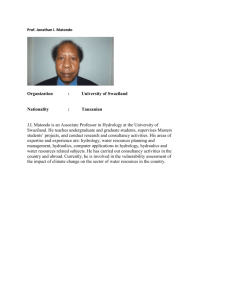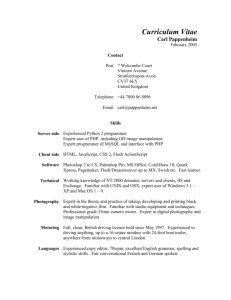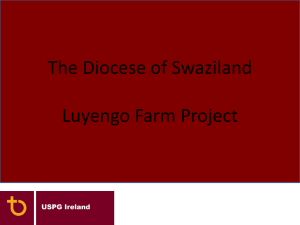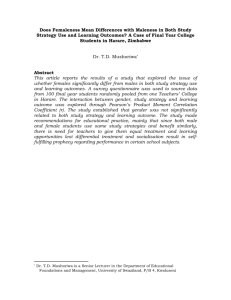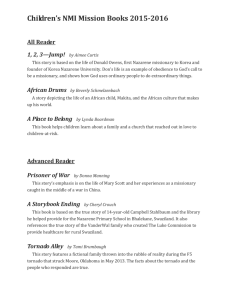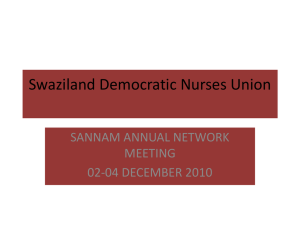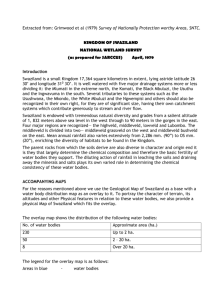Swaziland
advertisement
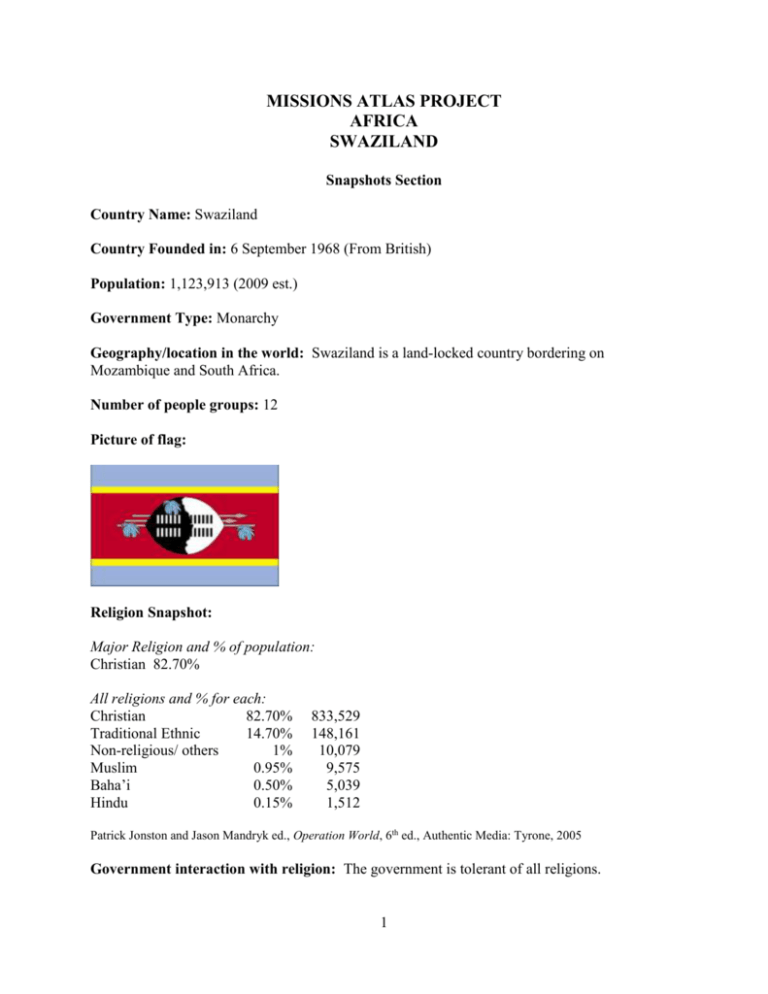
MISSIONS ATLAS PROJECT AFRICA SWAZILAND Snapshots Section Country Name: Swaziland Country Founded in: 6 September 1968 (From British) Population: 1,123,913 (2009 est.) Government Type: Monarchy Geography/location in the world: Swaziland is a land-locked country bordering on Mozambique and South Africa. Number of people groups: 12 Picture of flag: Religion Snapshot: Major Religion and % of population: Christian 82.70% All religions and % for each: Christian 82.70% Traditional Ethnic 14.70% Non-religious/ others 1% Muslim 0.95% Baha’i 0.50% Hindu 0.15% 833,529 148,161 10,079 9,575 5,039 1,512 Patrick Jonston and Jason Mandryk ed., Operation World, 6th ed., Authentic Media: Tyrone, 2005 Government interaction with religion: The government is tolerant of all religions. 1 Country Profile Basic Facts Country Name: Swaziland (Kingdom of Swaziland) Demographics: As of July 2009, the population of Swaziland was 1,123,913. The population growth rate is -0.459%. The birth rate is 26.25 births/ 1,000. The death rate is 30.83 deaths/ 1,000. The infant mortality rate is 68.63 deaths/ 1,000 live births: 71.87 deaths for male/ 1,000 live births and 65.29 deaths for female/ 1,000 live births. The life expectancy is 31.88 years: 31.62 years for men and 32.15 for women. The total fertility rate is 3.23 children born/ woman. The urban population was 25% of the total population in 2008. According to the UN, the growth rate of urban areas is 0.98% every year. The population in Mbabane, the capital city of Swaziland, was 70,000 in 2005. As of 2007, the adult prevalence rate of HIV/AIDS was 26.1%. 190,000 people live with HIV/AIDS and 10,000 had died due to HIV/AIDS. The HIV/AIDS is the cause of high death rate, infant mortality rate, and lower life expectancy. The population is composed of African (95%) and European (3%). https://www.cia.gov/library/publications/the-world-factbook/geos/wz.html Timothy L. Gall, ed. Worldmark Encyclopedia of the Nations. “Africa.” Vol. 2. Farmington Hills, Michigan: Gale Group, 2001 Language: English and siSwati are the official languages. Government business is conducted in English. https://www.cia.gov/library/publications/the-world-factbook/geos/wz.html Society/Culture: Major Holidays: September 6 is Independence Day in Swaziland. The other important holiday is Incwala. The Incwala celebrates for the king’s growth. It is a good resource to understand Swaziland society. For 3 weeks before Incwala, Swazi people have performances and preparatory activities. Then, the oldest warrior regiment opens the Incwala. It purposes the unity of society and reinforcement kingship. People wear the traditional clothes with decoration of bird feathers and skins of wild animals. https://www.cia.gov/library/publications/the-world-factbook/geos/wz.html 2 Education: Even though there are primary school for 7 years and secondary school for 5 year, schooling for children is not compulsory. The enrollment in primary schools is 75% and that of secondary school is 32% in 2003. The University of Swaziland and the Swaziland College of Technology are higher educational institutes. Approximately 5% of age-eligible students enrolled in the tertiary school. Timothy L. Gall, ed. Worldmark Encyclopedia of the Nations. “Africa.” Vol. 2. Farmington Hills, Michigan: Gale Group, 2001 Housing: The lack of urban housing is an important problem. People searching for jobs are staying in urban areas. As a result, about 60% of urban residences live in temporary shelters. Religion: Most of the Swazi people practice Christianity. About 40% of Christians belong to the Zionist Church. The Church has been mixed with Christianity and Ancestral worship. The followers of Roman Catholicism are approximately 20%. About 10% of population belongs to Muslim, Jews, or Baha’I faiths. The primary traditional religion of Swaziland is ancestral worship. They believe that a god, Mkhulumnqande, created the earth. This god is not related to ancestral worship. However, they believe that the spirits of ancestors (emadloti) are in a hierarchy. In the traditional religions, men take important roles offering sacrifices and women can communicate with spirits. Ancestral sprits are believed to have diverse forms and influence Swazi’s everyday life. Although adherents of traditional religions have decreased, many Swazis still follow and practice traditional religions. In traditional religions, the role of kings was important. They took the role of mediators between Swazi and ancestors. Ancestor worship had been common in ancient society. Foreign and animal spirits have been worshiped since the19th century. Health: 80% of population depends on traditional healers for health. There are 18 physicians, 2 dentists, 4 pharmacists, and 320 nurses per 100,000 people in 2004. HIV/AISD is an important issue affecting life expectancy. UNAIDS pointed out that Swaziland is the one of the countries with the highest prevalence rate of HIV/AISD in the world in 2006. The other major health problems are bilharzias, typhoid, tapeworm, gastroenteritis, malaria, kwashiorkor, and pellagra. Timothy L. Gall, ed. Worldmark Encyclopedia of the Nations. “Africa.” Vol. 1. Farmington Hills, Michigan: Gale Group, 2001 Government: Swaziland gained independence from England on September 6, 1968. The country established monarchy under the rule of a king. It is different from a parliamentary system. The prime minister is the head of government. Executive Branch The chief of state is the king. Currently, Mswati III is the king since April 25, 1986.The executive power in Swaziland consists of the cabinet recommended by the prime minister and confirmed by the monarchy. The prime minister is appointed by the monarchy from among the 3 elected members of the House of Assembly. The current prime minister is Barnabas Sibusiso Dlamini since October 16, 2008. Legislative Branch The bicameral Parliament (Libandla) consists of the Senate and the House of Assembly. The Senate consists of 30 seats: 10 of them are appointed by the House of Assembly and 20 are appointed by the monarchy to serve a five-year term. The House of Assembly consists of 65 seats: 10 members are appointed by the monarchy and 55 members are elected by popular vote. Judicial Branch The legal system is based on South-African Roman Dutch law in statutory courts, Swazi traditional laws and customs in traditional courts. The judicial branch consists of the High Court and Supreme Court. Judges for both courts are appointed by monarchy. Political parties Political parties were banned. However, after the new constitution was established, it is in debate. Currently, 3 associations are considered political. The constitution was signed by the king in 2005 and became effective in 2006. https://www.cia.gov/library/publications/the-world-factbook/geos/wz.html Economy: The gross domestic product (GDP) was $5.703 billion in 2008. This ranked Swaziland as 155 among the countries. The GDP real growth rate was 2.7%. The gross income per capita was $5,100. The GDP is composed of these sectors: agriculture (11.2%), industry (46%), and services (42.8%). Concerning the budget, Swaziland's revenues are $1.055 billion and expenditures were $1.083 billion in 2008. The national external debts of Swaziland were $554 million in 2008. The inflation rate was 12.6% in 2008. The Swaziland's currency is the Emalangeni. The exchange rate is 7.75 Emalangeni per US dollar. Swaziland's exports were $1.759 billion in 2008. Export commodities include soft drink concentrate, sugar, wood pulp, cotton yarn, refrigerators, citrus, and canned fruit. The imports were $1.858 billion. Import commodities include motor vehicles, machinery, transport equipment, foodstuffs, petroleum products, and chemicals. Swaziland depends on South Africa for its exports and imports. Approximately 90% of exports and 60% of imports are traded with South Africa. The labor force was estimated at 457,000 employees in 2007. The unemployment rate was 40% in 2006. The rate of population below poverty line was 69% in 2006. 4 https://www.cia.gov/library/publications/the-world-factbook/geos/wz.html Literacy: As of 2003, approximately 81.6% of Swaziland's total population 15 years of age or older, can read and write: 82.6% for male and 80.8% for female. https://www.cia.gov/library/publications/the-world-factbook/geos/wz.html Land/Geography: Swaziland is a country in Southern Africa. It is bounded by Mozambique and South Africa. Swaziland is the smallest country in Southern Africa. The borderline is 535 kilometer (323 mi) long. Swaziland’s total area including land (17,204 sq.km; 6,563 sq. mi) and water (160 sq. km; 61.7 sq. mi) is 17,364 sq. km (6,704sq. mi). Swaziland is slightly smaller than the US state of New Jersey. Swaziland’s landscape is mostly mountainous and hills. Some of the area is moderately sloping plains. The highest peak in Swaziland is Emlembe, reaching 1,862 meters (6,108 ft.). The lowest point is the Great Usutu River (21 meters; 68ft.). Swaziland is one of the best watered areas in Southern Africa in that every area is transcended by rivers or streams. The Great Usutu River is the longest river in Swaziland, reaching from west to east across the center of the country with a total distance of 217 km (135mi.). The climate in Swaziland varies from tropical to near temperate. The climate of high places is humid and temperate with 140 cm (55 in) of annual rainfall. The climate of middle places is somewhat drier and subtropical with 85 cm (33 in) of the annual rainfall. The climate of the lowest places is tropical with 60 cm (24 in) of annual rainfall. The rainy season lasts from October to March. The temperature varies from -3°C (27°F) to 42°C (108°F). The capital city of Swaziland is Mbabane located in the northwest part of the country. Swaziland has 4 districts: Hhohho, Lubombo, Manzini, and Shiselweni. https://www.cia.gov/library/publications/the-world-factbook/geos/wz.html http://www.strategyleader.org/profiles/swazi.html Timothy L. Gall, ed. Worldmark Encyclopedia of the Nations. “Africa.” Vol. 1. Farmington Hills, Michigan: Gale Group, 2001 History The Swazi people, the first immigrants, came from east Central Africa and settled in the area which is now Mozambique in the 15th century. The Ndwandwe people already lived in the land and conflicts between these two people groups occurred. Because of defeat in the battle, the Swazi people moved to part of Zululand in the middle of the 16th century. From then, they moved to the northern area which is now Swaziland. They expanded their territory to the north and the west and consolidated the Nguni, Sotho, and Thonga speaking people. 5 Swaziland was named after the king Mswati II in the 17th century. He asked the British to protect the country from Zulu invasion. As the result of this contact, the European people settled into Swaziland. The Swazi allowed British and Transvaal, which is now South Africa, to give authority and take responsibility of security. The establishment of a government was completed by Swaziland, Britain, and Transvaal in 1890. From 1894 to 1902, Swaziland was under the administration of Transvaal. After victory in the Zulu war, the administration was transferred to the British who added Swaziland as a protectorate in 1902. The British allowed Swaziland to keep the monarchy under a Residence Commissioner. While the British administered Swaziland, Queen Regent Lobatsibeni ruled over 20 years. In 1921, her grandson, Sobhuza II became the head of the nation. He ruled Swaziland for 47 years before independence. He tried to recover the authority of Swaziland from Britain. The first legislative body, an elected European Advisory Council, in Swaziland was established in 1921. The advisory body supported the British high commissioner excluding the Swazi affairs. The paramount chief (the ngwenyama) was considered as a position of native authority by the provision of the Native Administration Proclamation in 1941. During World War II, Britain requested that Sobhuza II send men to join the British army. He sent 4,000 men to North Africa and Italy. The British wanted the consolidation of Swaziland and South Africa, but prepared for the independence of Swaziland because of the rebellions against racial discrimination in South Africa. Several political parties were formed. One being the Imbokodvo National Movement (INM) the largest party formed, by the king Sobhuza II. The first election for the legislative council was held in 1964 and INM took all 24 elective seats. In 1965 the constitutional discussion for independence of Swaziland took place in London. After this discussion in 1965 and the agreement of the first constitution in 1966, Swaziland gained independence within the Commonwealth on September 6, 1968. A new parliament was formed by an indirect election and appointment in 1979. After King Sobhuza II died in 1982, a power struggle took place. His wife, the Queen Mother Dzeliw, became head of the nation. However, the king’s advisory council withdrew support of the queen and appointed as Queen Regent, one of the Sobhuza’s other wives, to be head of the nation. Following, they announced that Makhosetive, one of king’s sons, would become king after he was grown up. On April 25, 1986, he was crowned King Mwati III. http://www.sntc.org.sz/cultural/history.asp http://www.infoplease.com/country/profiles/swaziland.html Timothy L. Gall, ed. Worldmark Encyclopedia of the Nations. “Africa.” Vol. 2. Farmington Hills, Michigan: Gale Group, 2001 Christian History Christianity has been playing an important role in Swaziland politics, religions, and history. 6 During the reign of King Mswati II, he asked missionaries to come. It was confirmed in a Wesleyan missionary conference in 1844. James Allison, Richard Giddy, and two Sotho evangelicals were the first missionaries sent as the result of the Conference in Swaziland. They established the first Wesleyan mission in Mahamba and in 1882 it was reestablished. In later years, other missionaries established mission organization. Joel Jackson established the Anglican Society for the Propagation of the Gospel at Ndlotance in 1871 and in 1881. Some missionaries established not only mission stations, but also schools. British Missions built a school at Luyengo. German Lutheran missionaries came in 1887 and they started the South Africa General Mission at Bethany near the Great Usutu River in 1891. The independent Methodist Church was started since 1906. The Methodist Church is the largest denomination in Swaziland. Catholics started missionary work later than Protestants. The first missionaries of the Order of the Servants of Mary came in 1913. The Catholic population has been steadily growing since World War II. The Baptists started in Swaziland in 1983. Since the 1990s, the renewal movements, lead by the of Pentecostal / Charismatic churches, have dramatically increased. http://www.strategyleader.org/profiles/swazi.html Religion Non Christian Islam - Approximately 0.95% of the total population (9600) is estimated to be Muslim. Islam, reports an annual growth rate of +4/0%. Hinduism - About 1, 500 people followed Hindus in 2005. Baha’I - About 5,000 people practice Baha’I teachings. Traditional Religions - Approximately 14.7% (more than 165,200) of the total population follows traditional religions in Swaziland. Traditional religions are increasing at an annual rate of +1.2%. Non-religious - Around 10,000 people (1%) do not have any religions. Jehovah’s Witnesses - There were around 2,600 members in 61 congregations in 2005. Catholic/Orthodox - Catholicism claims 4.74 % of the population or around 48,000 people. The Catholic Church reports + 2.1% annual growth rate, compared to the 0.6% annual growth rate among the Protestant church. Christian/Evangelical 7 Anglican - The Anglican Church had 77 congregations with 3,850 members. The annual growth rate is a disturbing – 8.5%. Assembly of God - The Assembly of God had 61 congregations and almost 8,000 members. Methodists - The Methodists had 106 congregations with nearly 4,500 members. Methodist churches mainly exist in southwestern, central, and eastern in Swaziland. Nazarenes - Most Nazarene churches are found in the northeast in Swaziland. There were 115 congregations with 9,500 members in 2005. Independent churches found in the country - The Independent African Church is known as Zionist churches . The church encourages Christians to have spiritual gifts such as healings and speaking in tongues. Christians in this church accept traditional customs and practices. In all, some 83 different African Independent churches serve in Swaziland with a combined membership of 615,000 or 61.04% of the population. African Independent Churches report a growth rate of 5.2% annually. http://www.strategyleader.org/profiles/swazi.html People Groups 100093 Afrikaner (14,218) The primary language of Afrikaner is Afrikaans. The primary religion of the Afrikaner is Christianity (82%). They have access to Bible translations, the Jesus film, radio broadcasts, and Gospel recordings. According to Global Status of Evangelical Christianity Model, Evangelicals in Afrikaner are greater than or equal to 5% of total population. http://www.finishthetask.org/research/default.asp?country=Swaziland 102927 British (8,203) The primary language of British is English. The primary religion of the British is Christianity (79%). They have access to Bible translations, the Jesus film, radio broadcasts, and Gospel recordings. According to Global Status of Evangelical Christianity Model, Evangelicals among the British are greater than or equal to 5% of total population. http://www.finishthetask.org/research/default.asp?country=Swaziland 102264 Coloured (11,100) 8 The primary language of the Coloured is Afrikaans. The primary religion of the Coloured is Christianity (90%). They have access to Bible translations, the Jesus film, Gospel recordings, and radio broadcasts. 211080 Comorian, Maire (631) The primary language is Comorian. The primary religion of Comorian is Islam. There is one church for the Comorian people. http://www.finishthetask.org/research/default.asp?country=Swaziland 114916 Deaf The primary language of the Deaf is unknown. The primary religion of the Deaf is Christianity (82.70%). The accessibility of evangelical tools is unknown. 102964 Eurafrican, Coloured (3,330) The primary language of the Eurafrican people is English. The primary religion of the Eurafrican is Christianity (90%). They have access to Bible translations, Gospel recordings, and the Jesus film. 104026 Indo-Pakistani (8,450) The primary language of Indo-Pakistan is Hindi. The primary religion of Indo-Pakistan is Hinduism. They have access to Bible translations, Gospel recordings, the Jesus film, and radio broadcasts in their language. 107548 Nyanja (6,234) The primary language of the Nyanja is Nyanja. The primary religion of the Nyanja is Christianity. They have access to Bible translations, Gospel recordings, the Jesus film, and radio broadcasts. There are 6 churches for the Nyanja people. http://www.finishthetask.org/research/default.asp?country=Swaziland 109431 Sotho (5,140) The primary language of the Sotho people is Sotho (Southern). The primary religion of the Sotho is Christianity (97%). They have access to Bible translations, the Jesus film, and Gospel 9 recordings. They are in need of radio broadcasts. There are 5 churches for the Sotho in Swaziland. http://www.finishthetask.org/research/default.asp?country=Swaziland 109648 Swazi, Tekeza (1,128,814) The primary language of the Swazi people is Swati. The Swazi speak English in business and commerce. Many of them also speak Zulu. The Swazi people have been settled in Swaziland since the 1750s.Their ancestors are from Central Africa. Approximately 30% of Swazi live in towns and cities. The Swazi people have similarities with the Zulu by language, culture, and history. The primary religion of the Swazi is Christianity (88%). However, Christianity in Swaziland has been mixed with traditional religions. They have access to Bible translations, Gospel recordings, the Jesus film, and radio broadcasts. There are 980 churches for the Swazi. http://www.finishthetask.org/research/default.asp?country=Swaziland http://www.strategyleader.org/profiles/swazi.html 110220 Tsonga, Shangaan (24,400) The primary language of the Tsonga people is Tsonga. The primary religion of the Tsonga is Christianity (92%). They have access to Bible translations, the Jesus film, Gospel recordings, and radio broadcasts. There are 19 churches for the Tsonga. http://www.finishthetask.org/research/default.asp?country=Swaziland 11193 Zulu (82,297) The primary language of the Zulu people group is Zulu. Their primary religion is Christianity (89%). They have access to Bible translations, the Jesus film, Gospel recordings, and radio broadcasts. There are 76 churches for the Zulu people. http://www.finishthetask.org/research/default.asp?country=Swaziland All of the information on people groups has been gathered from two websites, unless noted. These two websites are www.peoplegroups.org, www.joshuaproject.org, Missiological Implications 1. Evangelical Christians and churches should realize that while many Swazi people consider themselves to be Christian, they practice the traditional religions along with Christian practices. Around 80% of Swazi people claim to be Christians; however, only 10 27% are active in churches. Thus, evangelicals need to educate them to live as Christians and help them find real salvation in Christ. 2. Evangelical Christians and churches should provide helps in reaching followers of traditional religions and train local believers in their use. 3. Evangelical Christians and churches should recognize that many of those who profess Christianity are members of African Independent Churches. This relationship allows polygamy, witchcraft, ancestor veneration, and appeasement sacrifices. Evangelicals must help local believers reach out to these peoples. 4. Evangelical Christians and churches should help local believers change their churches to be more appealing to those in the Independent congregations. The presence of African Independent Churches often indicates that the existing churches are foreign in nature and not well contextualized to the culture. 5. Evangelical Christians and churches should seek ways to aid the local congregations to train church leaders for the churches. The country faces a severe leadership void. 6. Evangelical Christians and churches should seek ways to aid the peoples of Swaziland in dealing with the prevalence of AIDS. AIDS causes lower life expectancy and high death rates. Evangelicals need to help Christians to sustain their faith even in a difficult situation. In particular, many AIDS orphans cannot enroll in schools because they do not pay their tuitions. They need people to know that God is caring for them. Pictures http://www.joshuaproject.org Links https://www.cia.gov/library/publications/the-world-factbook/geos/wz.html http://www.imb.org/globalresearch/downloads.asp http://www.finishthetask.org/research/default.asp?country=Swaziland http://www.joshuaproject.org http://www.strategyleader.org/profiles/swazi.html 11
